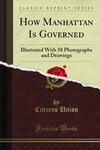The Bureau of Municipal Besmirch: A Tale of Accountability and Resentment
By Daniel Williams
From the Citizens Union's book, How Manhattan is Governed (1906), page 43.
In the first decade of the twentieth century, New York City was known for ethnic neighborhoods, Tammany Hall, and graft. William Riordon wrote a series of newspaper articles reporting his interviews with a Tammany Sachem, George Washington Plunkitt, who expounded on “honest graft.” The series became a book in 1905. In 1906, R. Fulton Cutting convinced the Citizens’ Union to provide a home to a new organization called the “Bureau of City Betterment.”
Cutting was a prominent New Yorker, named after his grandfather’s business partner, Robert Fulton (the first successful steamship entrepreneur), and he was a “Mugwump,” a movement associated with late 19th and early 20th century good government organizations, a precursor to the Progressive movement.
The Bureau of City Betterment’s first secretary, Henry Bruère, was tasked to look into the city baths, but was denied access to the records. Next he tried to look into the Manhattan Borough President’s management of public works. However, Borough President John F. Ahearn (another Tammany sachem) refused to make relevant records available for inspection. As later reported, “Rather than spend, money and valuable time in obtaining access to records by judicial process, it was decided to go to work on what lay out doors” (Municipal Research v.71, 1916, p. 4). The result was a pamphlet, How Manhattan is Governed.
Notwithstanding the previous quote, How Manhattan is Governed actually contains quite extensive information from public records. However, it also reflects “out doors” observations including over 50 photographs that typically demonstrated the poor quality of street repair, and a report from “two watchers to record the number of persons entering the West Forty-first Street Bath during the week ending January 14, 1905,” (p. 114) which led to the conclusion that the number of people served was almost tripled in the official report.
Ahearn
Scandal!
While much of the report is a rather dry recounting of the management and financing of Manhattan government, portions show such practices as excessive patronage hiring, acceptance of poor quality street paving work, and skirting the law with respect to soliciting bids for major expenses. It suggested that William Dalton, Commissioner of Public Works in Manhattan was an unqualified party hack. And, it suggested that Borough President Ahearn used a variety of means to raid the public treasury. On November 24, 1906, The New York Times reported:
The Bureau of City Betterment of the Citizens' Union, in a pamphlet Issued to the public yesterday, made charges against the administration of John F. Ahearn as Borough President of Manhattan. It is charged, among other things that he has expended $1,022,947 without public letting, and has been extravagant in his purchase of supplies; also, that he had spent in two years nearly $41.000 for 'incidentals,' the chief item of which was carfare.
It so happened that at this same time Ahearn was in conflict with Mayor McClellan. McClellan proposed that Governor Hughes investigate Ahearn’s administration. Governor Hughes kicked the ball back to McClellan saying that he had the authority to investigate, which he then did. Ahearn refused to cooperate with the investigation or attend hearings. However, he did fire Dalton. Dalton, in turn testified that Ahearn offered him business opportunities in exchange for serving as a scapegoat. District Attorney William Jerome became involved and pressured Dalton for more testimony. Bad news continued through the spring and early summer of 1907 with Commissioner of Accounts (and future mayor), John Purroy Mitchel, taking up yet another investigation. In July, McClellan referred the matter back to Hughes while the City Club asked the governor to remove Ahearn charging “misconduct, incompetence, neglect and waste of city moneys.” Hughes then conducted and additional investigation and on December 9, removed Ahearn. The aldermen then promptly reelected Ahearn as Borough President overriding the Mayor’s ruling that he was ineligible. The Mayor barred him from the Board of Estimate. By December he was sued first by New York State Attorney General Jackson and then by the City Club and the Citizens’ Union each seeking to permanently remove him from office. In 1909, the courts finally and permanently removed him.
Meanwhile, the Bureau of City Betterment, newly converted into a separate organization renamed the Bureau of Municipal Research, conducted other investigations and made more reports suggesting more corruption. Mayor McClellan, who, after all, was still a member of Tammany, did not always act as the Bureau requested. Tammany, was not so fond of this organization. Consequently in 1909, Parks Commissioner, Henry Smith referred to it as the “Municipal Besmirch Society,” which soon became the “Bureau of Municipal Besmirch.” The Bureau of Municipal Research embraced this attack, labeling it free adverting. It flourished under different names for the better part of the next century. Its archives were donated to Baruch College in 2009 and recently become accessible for research. You can search them here.
Daniel W. Williams is a Professor at Baruch College, CUNY.


